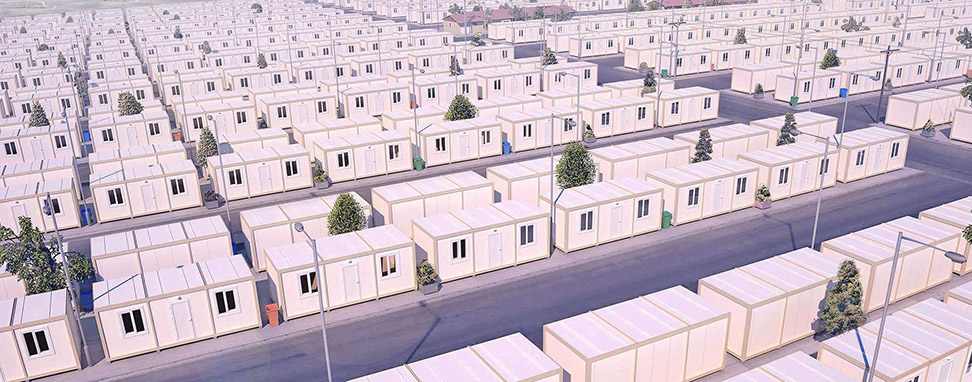In modern architectural design, flat-pack container houses are rapidly becoming the focus of global attention due to their flexibility, economy and sustainability. This new form of construction is particularly suitable for quickly built residential, office, commercial space and disaster relief facilities. It can not only reduce construction time and cost, but also meet people's needs for green environmental protection and efficient construction.
The prefabrication and modularity of flat-pack container houses make them extremely fast to install. After the foundation is prepared, a complete house can be built with simple on-site assembly, and the construction time is significantly shorter than traditional buildings. This form of construction can be completed in a few hours to a few days, which is particularly suitable for occasions that require quick occupancy.

Because the building materials and processes of flat-pack container houses are relatively simple, the production and assembly costs are relatively low. Modular design reduces labor demand and construction time, reduces on-site construction waste, and reduces construction costs. In addition, its transportation method is also very economical. Through flat packing, multiple container house units can be loaded in one shipping container, greatly reducing long-distance transportation costs.
Flat-pack container houses are made of steel structures and recyclable materials. Their structures are stable and durable, and their life cycle is long. The modular design allows each unit to be disassembled and reassembled, which helps reduce construction waste and can be recycled. In addition, container houses can be optimized in terms of energy use, such as adding solar power generation and rainwater collection systems, to further achieve green environmental protection.
Flat-pack container houses can be modularly customized according to different needs. Whether it is adding rooms, renovating the internal layout or adjusting the exterior design, flexible changes can be achieved. This feature makes it suitable for a variety of uses such as residences, offices, shops, showrooms, etc., and can also be customized according to the needs of different geographical environments and adapt to various climatic conditions.
The steel structure of flat-pack container houses is not only durable, but also has excellent seismic resistance. Especially in areas where earthquakes occur frequently, the stability and impact resistance of container houses can protect the safety of residents. In addition, they have high wind and fire resistance, and are particularly suitable for emergency disaster resettlement houses and outdoor living facilities under extreme conditions.
In cities or remote areas with high housing demand, flat-pack container houses are low-cost and efficient residential solutions. Through modular combinations, residential units can be added in limited space, which is particularly suitable for developing cities. In remote areas, the convenient transportation and installation characteristics of container houses also enable areas with imperfect infrastructure to quickly build habitable houses.
Flat-pack container houses are also suitable for occasions such as temporary office buildings, shops and exhibition halls. For example, construction sites can quickly build construction offices, while shops or exhibition activities can establish display spaces that attract customers in a short period of time. In addition, the flexible design of container houses can be personalized according to brand needs to form a unique business environment.
In the emergency stage after a natural disaster, flat-pack container houses are an ideal resettlement housing solution. Its quick installation and convenient transportation allow it to quickly build a safe space for people to live in the disaster area. This can not only provide shelter for disaster victims in a timely manner, but also serve as temporary hospitals, schools and other public facilities to help the disaster area restore normal life order.
Flat-pack container houses are increasingly used in tourist camps, resorts and outdoor adventure projects. This convenient and movable building form is very suitable for outdoor environments, especially in areas with beautiful scenery and inconvenient transportation. Container houses can be built into environmentally friendly holiday cabins, providing tourists with a zero-distance contact with nature without causing damage to the environment.
With the continuous improvement of environmental awareness, flat-pack container houses will integrate more green energy technologies in the future, such as solar panels, wind power generation equipment, etc., to achieve self-sufficient energy needs. This will make container houses more applicable in remote areas and outdoor environments, and is expected to become a zero-emission building form.
With the development of Internet of Things technology, flat-pack container houses can be embedded with intelligent management systems, such as temperature control, security monitoring, lighting management, etc., so that residents can enjoy a convenient and comfortable living experience. Especially for outdoor application scenarios, the intelligent monitoring system can improve safety and grasp the use status and environmental conditions of the house in real time.
The modular design of flat-pack container houses will be further improved in the future to meet a variety of building needs. In addition to the use of a single container house, more complex building structures such as multi-story apartments and comprehensive commercial buildings can be built through the splicing and combination of different modules to adapt to a wider range of application scenarios.
With people's attention to environmental protection and efficient buildings, the global demand for flat-pack container houses will continue to increase. Especially in developing countries, flat-pack container houses can effectively alleviate the housing shortage problem and become an important force to promote sustainable development. The demand of the global market will promote the rapid development and technological innovation of related industries.








